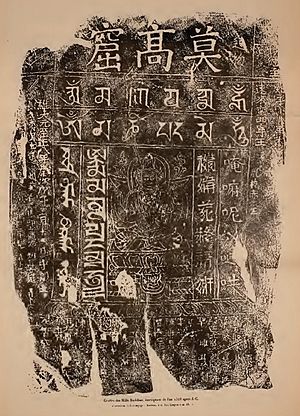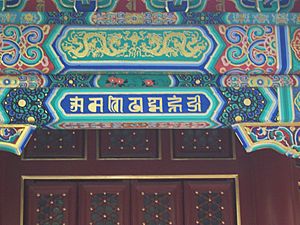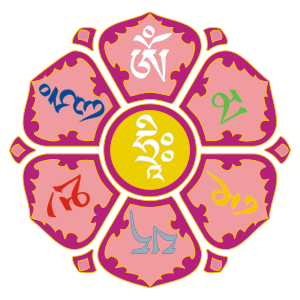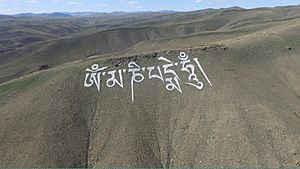Om mani padme hum facts for kids
Quick facts for kids Om mani padme hum |
|||||||
|---|---|---|---|---|---|---|---|
| Chinese name | |||||||
| Chinese | 唵嘛呢叭咪吽 | ||||||
|
|||||||
| Karandavyuha Sutra name | |||||||
| Chinese | 唵麼抳缽訥銘吽 | ||||||
|
|||||||
| Tibetan name | |||||||
| Tibetan | ཨོཾ་མ་ཎི་པདྨེ་ཧཱུྃ | ||||||
|
|||||||
| Vietnamese name | |||||||
| Vietnamese | Úm ma ni bát ni hồng Án ma ni bát di hồng |
||||||
| Thai name | |||||||
| Thai | โอํ มณิ ปทฺเม หุํ | ||||||
| Korean name | |||||||
| Hangul | 옴 마니 반메 훔 옴 마니 파드메 훔 |
||||||
|
|||||||
| Mongolian name | |||||||
| Mongolian Cyrillic | Ум мани бадмэ хум Om mani badme khum |
||||||
| Mongolian script | ᢀᠣᠸᠠ ᠮᠠᢏᢈ ᢒᠠᢑᠮᠧ ᢀᠾᠤᠤ |
||||||
|
|||||||
| Japanese name | |||||||
| Kana | オーム マニ パドメー フーム オム マニ ペメ フム |
||||||
|
|||||||
| Tamil name | |||||||
| Tamil | ௐ மணி பத்மே ஹூம் | ||||||
| Hindi name | |||||||
| Hindi | ॐ मणि पद्मे हूँ | ||||||
| Sanskrit name | |||||||
| Sanskrit | Devanagari: ॐ मणि पद्मे हूँ Siddham: 𑖌𑖼𑖦𑖜𑖰𑖢𑖟𑖿𑖦𑖸𑖮𑖳𑖽 |
||||||
| Russian name | |||||||
| Russian | Ом мани падме хум | ||||||
| Bengali name | |||||||
| Bengali | ওঁ মণি পদ্মে হূঁ | ||||||
| Assamese name | |||||||
| Assamese | ওঁ মণি পদ্মে হূঁ | ||||||
| Nepali name | |||||||
| Nepali | ॐ মণি পদ্মে हूँ | ||||||
| Burmese name | |||||||
| Burmese | ဥုံ မဏိ ပဒ္မေ ဟုံ | ||||||
| IPA | [òʊɰ̃ ma nḭ paʔ mè hòʊɰ̃] | ||||||
| Malayalam name | |||||||
| Malayalam | ഓം മണി പദ്മേ ഹും | ||||||
| Odia name | |||||||
| Odia | ଓଁ ମଣି ପଦ୍ମେ ହୁଁ | ||||||
| Marathi name | |||||||
| Marathi | ॐ मणि पद्मे हूँ | ||||||
| Punjabi name | |||||||
| Punjabi | ਓਮ ਮਣਿ ਪਡਮੇ ਹੂਁ | ||||||
| Meitei name | |||||||
| Meitei | ꯑꯣꯝ ꯃꯅꯤ ꯄꯗ꯭ꯃꯦ ꯍꨨꯝ | ||||||
The phrase Oṃ maṇi padme hūṃ is a very important Sanskrit mantra in Buddhism. It has six syllables and is often linked to Avalokiteshvara. This is a bodhisattva (a wise being) known for great compassion.
This mantra first appeared in an old Buddhist text called the Kāraṇḍavyūhasūtra. In this text, the mantra is seen as a short way to understand all Buddhist teachings. It is also called the "innermost heart" of Avalokiteshvara.
The exact meaning of the words is still discussed by Buddhist scholars. A common translation in English is "praise to the jewel in the lotus." Another idea is "I in the jewel-lotus." The word Padma means "lotus" and mani means "jewel." The lotus flower is a symbol of purity in many Asian religions. The first word, aum/om, is a sacred sound in many Indian religions. The last word, hum, stands for the spirit of awakening.
In Tibetan Buddhism, this mantra is very common. Many people, both monks and regular people, say it as a religious practice. You can see it carved on rocks, called mani stones. It is also painted on hillsides or written on prayer flags and prayer wheels.
Over time, this mantra also became part of Chinese Buddhism. This happened because Chinese Buddhists interacted more with Tibetans and Mongolians. The mantra has even been used in Chinese Taoism.
Contents
What Does the Mantra Mean?
Mantras can be understood in many ways. Some people believe their power comes from the sounds themselves, not just their exact meaning.
The Words: Jewel and Lotus
The middle part of the mantra, maṇipadme, is often thought to mean "jewel in the lotus." The word maṇí means "jewel" or "gem." The word padma means "lotus." The lotus flower is a symbol of purity because it grows clean out of muddy water. It also represents spiritual growth and awakening.
The mantra starts with oṃ and ends with hūṃ. These are sacred sounds that do not have a direct word meaning. They are known as divine sounds.
Some scholars believe maṇipadme is actually a way of speaking directly to a bodhisattva named maṇipadma. This name means "Jewel-Lotus" and is another name for Avalokitesvara.
Teachings from the Kāraṇḍavyūhasūtra
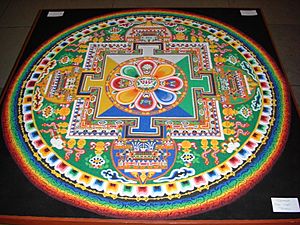
The first known mention of this mantra is in the Kāraṇḍavyūhasūtra. This ancient text was written around the 4th or 5th century. In this sutra, Shakyamuni Buddha says that this mantra is very helpful. He says he learned it from Buddha Amitabha.
The sutra teaches that saying this mantra can help you reach liberation. It says that anyone who understands the mantra will find freedom, like a fully enlightened Buddha. To practice this mantra, it is important to receive special permission from a qualified teacher. This permission is open to all Buddhists.
The Kāraṇḍavyūhasūtra also says the mantra is like the main idea of all Buddhist teachings. It is called "the grain of rice of the Mahayana." Saying it is like saying many other important Buddhist texts.
Practicing this mantra can lead to many good things. These include seeing Avalokitesvara in a special way. It can also help you develop "great compassion" and gain much good karma. It can also help you achieve awakening.
In this sutra, the mantra also appears as a goddess. She is described as having four arms. Two arms hold a lotus and prayer beads. The other two are held in a prayer gesture.
The Mantra in Tibetan Buddhism
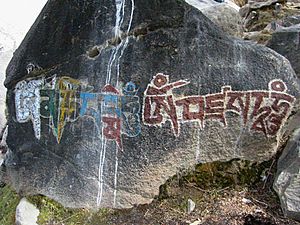
The Bengali master Atiśa Dīpaṃkara Śrījñāna helped bring Buddhism to Tibet in the 11th century. He wrote a short book about the mantra. The main source for Tibetan practices of Avalokitesvara is the 11th-century Maṇi Kambum.
Most Tibetan Buddhist texts focus on how each of the six syllables of the mantra connects to different Buddhist ideas. They do not focus as much on a direct translation.
For example, in one teaching, each syllable helps purify a different problem or leads to a different good quality:
| Syllable | Six Pāramitās (Perfections) | Purifies (Cleanses) | Samsaric realm (World of Suffering) | Colors | Symbol of the Deity | (Wish them) To be born in |
|---|---|---|---|---|---|---|
| Om | Generosity | Pride / Ego | Gods | White | Wisdom | Perfect Realm of Potala |
| Ma | Ethics (Good behavior) | Jealousy | Demigods | Green | Compassion | Perfect Realm of Potala |
| Ni | Patience | Desire | Humans | Yellow | Body, speech, mind, quality, and activity | Dewachen (Pure Land) |
| Pad | Diligence (Hard work) | Ignorance | Animals | Blue | Equanimity (Calmness) | The presence of Protector (Chenrezig) |
| Me | Renunciation (Giving up) | Greed | Hungry ghosts | Red | Bliss (Great joy) | Perfect Realm of Potala |
| Hum | Wisdom | Hatred | Hell beings | Black | Quality of Compassion | The presence of the Lotus Throne (of Chenrezig) |
The 14th Dalai Lama's Explanation
The Tenzin Gyatso, 14th Dalai Lama explained the mantra's meaning: "It is good to say 'Om mani padme hung'. But you should think about its meaning. The meaning of the six syllables is great and wide.
The first syllable, Om, shows your impure body, speech, and mind. It also shows the pure body, speech, and mind of a Buddha.
The next four syllables show the middle path. Mani, meaning jewel, stands for good methods. These include wanting to help others become enlightened, compassion, and love.
The two syllables, padme, meaning lotus, stand for wisdom.
You must achieve purity by combining method and wisdom. This is shown by the last syllable, hung. It means they cannot be separated.
So, the six syllables, 'Om mani padme hung', mean this: By practicing a path that combines method and wisdom, you can change your impure body, speech, and mind into the pure body, speech, and mind of a Buddha."
Dilgo Khyentse Rinpoche's Explanation
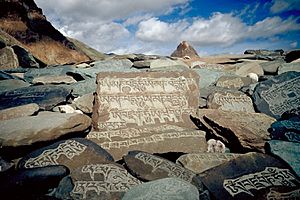
Dilgo Khyentse Rinpoche also explained the mantra: "The mantra Om Mani Pädme Hum is easy to say. But it is very powerful. It holds the main idea of all Buddhist teachings.
When you say the first syllable Om, it helps you be perfect in giving to others. Ma helps you be perfect in good behavior. Ni helps you be perfect in being patient. Pä, the fourth syllable, helps you be perfect in working hard. Me helps you be perfect in focusing your mind. The last syllable Hum helps you be perfect in wisdom.
So, saying the mantra helps you become perfect in these six practices. These six perfections are the path all Buddhas have followed. What could be more meaningful than saying this mantra and completing these six perfections?"
How the Mantra is Written
The mantra is written in different ways in English. This depends on the Buddhist school or teacher.
Most experts think maṇipadme is one word, not two separate ones. Sanskrit writing does not use capital letters. So, how the mantra is capitalized in English can change.
- IAST (Roman alphabet): Oṃ Maṇi Padme Hūṃ
- Tibetan: ཨོཾ་མ་ཎི་པདྨེ་ཧཱུྃ (Tibetan Pinyin: Om Mani Bêmê Hum)
- Sanskrit: ॐ मणिपद्मे हूँ (oṃ maṇipadme hūṃ)
- Mongolian:
- Classical Mongolian: ᢀᠣᠸᠠ
ᠮᠠᢏᢈ
ᢒᠠᢑᠮᠧ
ᢀᠾᠤᠤ (Owam mani padme huum) - Khalkha: Ум мани бадмэ хум (Um mani badme khum)
- Buryat: Ом маани бадмэ хум (Om maani badme khum)
- Kalmyk: Ом мани бадме хум (Om mani badme xum)
- Classical Mongolian: ᢀᠣᠸᠠ
- 'Phags pa: ʼom ma ni pad me hung ꡝꡡꡏ
ꡏ
ꡋꡞ
ꡌꡊ
ꡏꡠ
ꡜꡟꡃ - Manchu: ᢀᠣ
ᠮᠠᢏᡳ
ᢒᠠᡩᠮᡝ
ᢀᡥᡠᡠ (Om mani padme hüüm) - Tangut: 𗙫𗏵𗐱𗴟𗘺𗦀 ꞏa mja¹ nji² pja¹ mjij¹ xo
- Old Uyghur: oom mani badmi xung
- Jurchen:
 am ma ni ba mi xu
am ma ni ba mi xu - Meitei (Manipuri): ꯑꯣꯝ ꯃꯅꯤ ꯄꯗ꯭ꯃꯦ ꯍꨨꯝ (ōm manee padme hūng)
- Chinese: 唵嘛呢叭咪吽 (Ōng mā nī bēi mēi hōng) or 唵麼抳缽訥銘吽 (Wēng mó ní bō nè míng hōng)
- Korean: 옴 마니 반메 훔 (Om Mani Banme Hum) or 옴 마니 파드메 훔 (Om Mani Padeume Hum)
- Japanese: オーム・マニ・パドメー・フーム (Ōmu Mani Padomē Fūmu) or オムマニペメフム (Omu Mani Peme Fumu)
- Vietnamese: Án ma ni bát di hồng
- Siddham: 𑖌𑖼 𑖦𑖜𑖰 𑖢𑖟𑖿𑖦𑖸 𑖮𑖲𑖼
- Lepcha: ᰣᰨᰵ ᰕᰍᰧ ᰎᰳᰕᰬ ᰝᰫᰵ
- Limbu: ᤀᤥᤱ ᤔᤏᤡ ᤐᤍ᤻ᤔᤣ ᤜ᤺ᤢᤱ
- Brahmi: 𑀑𑀁 𑀫𑀡𑀺 𑀧𑀤𑁆𑀫𑁂 𑀳𑀽𑀁
- Hindi: ॐ मणि पद्मे हूँ (om mani padme hum)
- Telugu: ఓం మణి పద్మే హుం
- Nepali: ॐ मणि पद्मे हुँ
- Pracalit (Newari): 𑑉 𑐩𑐞𑐶 𑐥𑐡𑑂𑐩𑐾 𑐴𑐸𑑃
- Assamese: ওঁ মণি পদ্মে হুঁ (Öm Moni Podme hum)
- Bengali: ওঁ মণি পদ্মে হুঁ (Om Moni Pôdde hum)
- Odia: ଓଁ ମଣି ପଦ୍ମେ ହୁଁ (Oṃ Maṇi Padme Huṃ)
- Sinhala: ඕං මණි පද්මේ හුං
- Tamil: ௐ மணி பத்மே ஹூம்
- Malayalam: ഓം മണി পദ്മേ হும்
- Kannada: ಓಂ ಮಣಿ পદ્মে হும்
- Grantha: 𑍐 𑌮𑌣𑌿 𑌪𑌦𑍄𑌮𑍇 𑌹𑍂𑌁
- Chakma: 𑄃𑄮𑄀 𑄟𑄧𑄕𑄨 𑄛𑄧𑄘𑄳𑄟𑄬 𑄦𑄪𑄀
- Burmese: ဥုံမဏိပဒ္မေဟုံ (Burmese pronunciation: [òʊɰ̃ ma nḭ paʔ mè hòʊɰ̃])
- Mon: ဥုံမဏိပဒၟေဟုံ
- Shan: ဢုုံမꧣိပၻ်မေႁုံ
- Lanna: ᩒᩴ ᨾᨱᩥ ᨸᨴ᩠ᨾᩮ ᩉᩪᩴ
- Thai: โอํ มณิ ปทฺเม หุํ
- Khmer: ឱំ មណិ បទ្មេ ហុំ
- Lao: ໂອໍ ມະນິ ປັທເມ ຫຸໍ
- Cham: ꨀꨯꨱꩌ ꨠꨘꨪ ꨚꩅꨠꨯꨮ ꨨꨭꨩꩃ
- Balinese: ᬑᬁ ᬫᬡᬶ ᬧᬤ᭄ᬫᬾ ᬳᬸᬁ
- Javanese: ꦎꦀ ꦩꦟꦶ ꦥꦢ꧀ꦩꦺ ꦲꦸꦀ
- Tagalog (Filipino): ᜂᜋ᜔ ᜋᜈᜒ ᜉᜇ᜔ ᜋᜒ ᜑᜓᜋ᜔ Um mani pad mi hum
Mantra Variations
Sometimes, the full Avalokiteshvara Mantra includes a final syllable, hrīḥ. This syllable is sometimes shown in the center of special designs called mandalas. The full mantra in Tibetan is: ཨོཾ་མ་ཎི་པདྨེ་ཧཱུྃ་ཧྲཱིཿ. The hrīḥ part is not always spoken aloud. It can be thought or felt "inside."
Old Tibetan writings from Dunhuang show many mantras linked to Avalokitesvara. The six-syllable mantra is just one of them. Some other variations are: Om vajra yaksa mani padme hum. Another variation is Om manipadme hum mitra svaha.
See also
 In Spanish: Om mani padme hum para niños
In Spanish: Om mani padme hum para niños
- Ye Dharma Hetu
- Maṇi Kambum
- Ashtamangala
- Great Compassion Mantra
- Heart sutra
- Samsara
- Samsara (2011 film)
- Shurangama Mantra
- Desire realm


